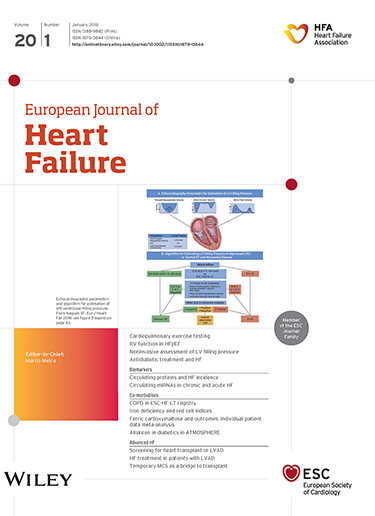Diuretic resistance and the efficacy of hydrochlorothiazide in acute decompensated heart failure: A post‐hoc analysis of the CLOROTIC trial
IF 10.8
1区 医学
Q1 CARDIAC & CARDIOVASCULAR SYSTEMS
引用次数: 0
Abstract
AimsDiuretic resistance (DR) in acute decompensated heart failure (ADHF) is associated with poor outcomes. The CLOROTIC trial demonstrated hydrochlorothiazide (HCTZ) with intravenous furosemide improved weight loss in ADHF. We assessed performance of the BAN‐ADHF DR score and association between DR risk and HCTZ treatment response.Methods and resultsWe included participants from CLOROTIC and assessed BAN‐ADHF performance in identifying lowest net diuretic efficiency phenogroup, as identified with a random forest classifier. Participants were stratified by the BAN‐ADHF score (≤12: low DR risk and >12: high DR risk) to compare treatment effect of HCTZ versus placebo across DR risk. Outcomes were weight change and area under the curve (AUC) of dyspnoea visual analogue scale (VAS) at 72/96 h, fluid loss at 72 h, and 30/90‐day mortality. Among 220 participants (50.9% male, mean age 83 years), the BAN‐ADHF score demonstrated good performance in identifying low net diuretic efficiency phenogroup (area under the receiver operating characteristic curve: 0.81). Weight change and VAS AUC at 72 h was similar across DR risk strata, however, participants with high versus low DR risk had lower fluid loss at 72 h (686 vs. 889 ml,利尿剂抵抗和氢氯噻嗪治疗急性失代偿性心力衰竭的疗效:CLOROTIC试验的事后分析
目的:急性失代偿性心力衰竭(ADHF)患者的利尿剂抵抗(DR)与不良预后相关。CLOROTIC试验表明氢氯噻嗪(HCTZ)联合静脉速尿可改善ADHF患者的体重减轻。我们评估了BAN - ADHF DR评分的表现以及DR风险与HCTZ治疗反应之间的关系。方法和结果我们纳入了来自cloortic的参与者,并评估了BAN - ADHF在识别最低净利尿效率表型方面的表现,并通过随机森林分类器进行了识别。通过BAN - ADHF评分(≤12:低DR风险,>;12:高DR风险)对参与者进行分层,比较HCTZ与安慰剂在DR风险中的治疗效果。结果是72/96 h时呼吸困难视觉模拟评分(VAS)的体重变化和曲线下面积(AUC), 72 h时体液流失,以及30/90天死亡率。在220名参与者中(50.9%为男性,平均年龄83岁),BAN - ADHF评分在识别低净利尿效率表型(受试者工作特征曲线下面积:0.81)方面表现良好。体重变化和72小时VAS AUC在DR风险层中相似,然而,高DR风险与低DR风险的参与者在72小时的液体损失较低(686 ml对889 ml, p = 0.003), 30天(11.1%对2.4%,p = 0.035)和90天死亡率较高(23.0%对10.6%,p = 0.033)。HCTZ(与安慰剂相比)对体重变化的治疗效果在DR风险中相似(72小时时品脱= 0.75;96小时时品脱= 0.50)。DR风险改变了HCTZ与安慰剂在呼吸困难VAS上的疗效,高DR风险(与低DR风险相比)在72小时(- 236对476毫米;品脱= 0.03)和96小时(- 400对777毫米;品脱= 0.001)时改善减弱。结论BAN - ADHF评分在识别DR方面表现良好,而高DR风险与较差的结果相关。在DR高危人群中,HCTZ治疗对体重减轻的效果相似,但在DR高危人群中,HCTZ治疗对呼吸困难的改善有所减弱。
本文章由计算机程序翻译,如有差异,请以英文原文为准。
求助全文
约1分钟内获得全文
求助全文
来源期刊

European Journal of Heart Failure
医学-心血管系统
CiteScore
27.30
自引率
11.50%
发文量
365
审稿时长
1 months
期刊介绍:
European Journal of Heart Failure is an international journal dedicated to advancing knowledge in the field of heart failure management. The journal publishes reviews and editorials aimed at improving understanding, prevention, investigation, and treatment of heart failure. It covers various disciplines such as molecular and cellular biology, pathology, physiology, electrophysiology, pharmacology, clinical sciences, social sciences, and population sciences. The journal welcomes submissions of manuscripts on basic, clinical, and population sciences, as well as original contributions on nursing, care of the elderly, primary care, health economics, and other related specialist fields. It is published monthly and has a readership that includes cardiologists, emergency room physicians, intensivists, internists, general physicians, cardiac nurses, diabetologists, epidemiologists, basic scientists focusing on cardiovascular research, and those working in rehabilitation. The journal is abstracted and indexed in various databases such as Academic Search, Embase, MEDLINE/PubMed, and Science Citation Index.
 求助内容:
求助内容: 应助结果提醒方式:
应助结果提醒方式:


